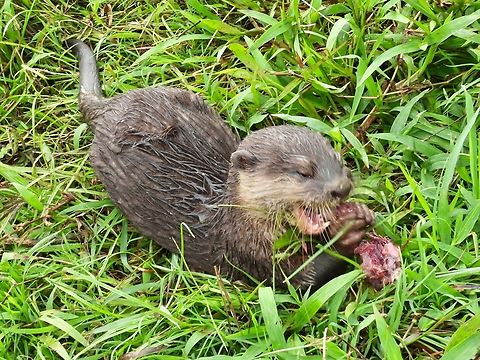
Appearance
The Asian small-clawed otter has deep brown fur with some rufous tinge on the back, but paler below. Its underfur is lighter near the base. The sides of the neck and head are brown, but its cheeks, upperlip, chin, throat and sides of the neck are whitish.Its skull is short, and the naked rhinarium rounded above. The muzzle has long coarse vibrissae on either side. Its eyes are located toward the front of the head. The small ears are oval-shaped with an inconspicuous tragus and antitragus. Its paws are narrow with short digits that are webbed to the last joint. There are short hairs on the lower sides of the interdigital webs. The four-lobed plantar pads are longer than wide. The claws are short, almost erect, and in some individuals even absent.
Females have four mammary glands.
The Asian small-clawed otter is the smallest otter species in Asia. In head-to-body length, it ranges from 470 to 610 mm with a 260 to 350 mm long tail. The tapering tail is thick and muscular, especially at the base, and more than half the length of the body. Hind feet are 97 to 102 mm long. Length of skull ranges from 3.3 to 3.7 in. It does not have upper premolars and only four postcanine teeth above.
Adult captive otters range in weight from 2.7 to 3.5 kg.
Distribution
The Asian small-clawed otter's native range comprises parts of India to Southeast Asia including the islands of Sumatra, Java, Borneo and Palawan. It lives in freshwater wetlands such as swamps, meandering rivers, irrigated rice fields as well as estuaries, coastal lagoons and tidal pools. It occurs in West Bengal, Assam and Arunachal Pradesh, and in coastal regions of Odisha. In Karnataka, Nilgiri and Palni hills in Tamil Nadu, it lives in shallow mountain creeks up to an elevation of 2,000 m.In West Java, it inhabits areas along slow-flowing irrigation channels, pond areas and rice fields surrounded by vegetation that offers shelter. It also occurs in mangroves.
In the 1980s, a few Asian small-clawed otters escaped from captivity in England and established a population in the wild.
Status
The Asian small-clawed otter was listed on CITES Appendix II and is protected in almost all range countries prohibiting its killing. Since August 2019, it is included in CITES Appendix I, thus strengthening its protection in regards to international trade.Behavior
The Asian small-clawed otter is mostly active after dark. It lives in groups of up to 15 individuals. In the Bangladesh Sundarbans, 53 individuals were recorded in 351 km of water courses in 13 locations between November 2014 and March 2015. Group size ranged from one to 12 individuals. Group members communicate using 12 or more distinct calls, and utter a variety of yelps and whimpers. When disturbed, they scream to rally the help of others.When swimming on the surface, otters row with the forelimbs and paddle with the hind limbs. When diving under water, they undulate their bodies and tails. Captive otters swim at speeds of 0.7–1.2 m/s.
Observations of wild Asian small-clawed otters revealed that they smear their spraint at latrine sites, using their hind feet and tails. Large groups smeared more than groups of three or fewer animals. The frequency of latrines with smeared scats varied in different locations, indicating a preference for certain sites. Spraint smearing most likely facilitates social ties among group members and is associated with territorial marking displays. They use grassy or sandy banks for resting, sun bathing and grooming. In marshes, they use mostly islands.
Reproduction
Information about the Asian small-clawed otter's mating and breeding behaviour has been studied in captive environments. Captive pairs are monogamous. The estrous cycle of females lasts 28 to 30 days with estrus lasting between one and 13 days. Usually, mating takes place in the water.Gestation lasts 62 to 86 days. Interval between births is at least eight months. About two weeks before parturition, both female and male engage in building a nest. They collect grass, hay or straw and carry this material into the breeding chamber. Between one and seven pups are born in a litter. Pups are born with closed eyes, which open in the fifth week.
Newborn pups weigh between 45.6 and 62.5 g and reach a weight of 410–988 g after 60 days. They start exploring the environs of the breeding den at the age of ten weeks. At about three months, they enter and paddle in shallow water under the guidance of the mother. They become independent at the age of four to five months.
Food
The Asian small-clawed otter feeds mainly on crabs, mudskippers and "Trichogaster" fish. Its diet varies seasonally. When and where available, it also catches snakes, frogs, insects, rats and ricefield fish like catfish, "Anabas testudineus" and "Channa striata".The size of crabs found in spraints in Huai Kha Khaeng Wildlife Sanctuary ranged in carapace width from 10 to 44 cm.
Captive Asian small-clawed otters were observed to leave shellfish in the sun, so that the heat causes them to open. That way, they consume the crustaceans without having to crush the shells.
Predators
The Asian small-clawed otter is threatened by poaching for its fur, loss and destruction of habitats such as hill streams, peat swamp forests and mangroves for aquaculture projects. Threats in India include deforestation, conversion of natural habitat for tea and coffee plantations, overfishing of rivers and water pollution through pesticides.It is the most sought after otter species for the illegal pet trade in Asia. At least 711 Asian small-clawed otters were offered for sale through online websites by 280 traders in Indonesia, Thailand, Malaysia and Vietnam between 2016 and 2017.
Between December 2015 and October 2018, 49 Asian small-clawed otters were confiscated from wildlife traffickers in Thailand, Vietnam and Japan; 35 of them were bound for sale in Japan.
References:
Some text fragments are auto parsed from Wikipedia.